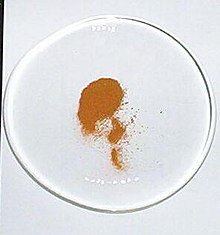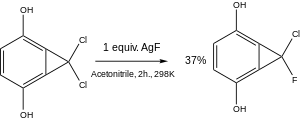
| |

| |
| Names | |
|---|---|
| IUPAC name Silver(I) fluoride | |
| Other names
Argentous fluoride Silver monofluoride | |
| Identifiers | |
| CAS Number | |
| 3D model (JSmol) | |
| ECHA InfoCard | 100.028.996 |
| PubChem CID | |
| RTECS number |
|
| UNII | |
| CompTox Dashboard (EPA) | |
SMILES
| |
| Properties | |
| Chemical formula | AgF |
| Molar mass | 126.8666 g·mol |
| Appearance | yellow-brown solid |
| Density | 5.852 g/cm (15 °C) |
| Melting point | 435 °C (815 °F; 708 K) |
| Boiling point | 1,159 °C (2,118 °F; 1,432 K) |
| Solubility in water | 85.78 g/100 mL (0 °C) 119.8 g/100 mL (10 °C) 179.1 g/100 mL (25 °C) 213.4 g/100 mL (50 °C) |
| Solubility | 83g/100 g (11.9 °C) in hydrogen fluoride 1.5g/100 mL in methanol(25 °C) |
| Magnetic susceptibility (χ) | −36.5·10 cm/mol |
| Structure | |
| Crystal structure | cubic |
| Thermochemistry | |
| Heat capacity (C) | 48.1 J/mol·K |
| Std molar entropy (S298) |
83.7 J/mol·K |
| Std enthalpy of formation (ΔfH298) |
-206 kJ/mol |
| Gibbs free energy (ΔfG) | -187.9 kJ/mol |
| Hazards | |
| Occupational safety and health (OHS/OSH): | |
| Main hazards | Corrosive |
| GHS labelling: | |
| Pictograms | 
|
| Signal word | Danger |
| Hazard statements | H314 |
| Precautionary statements | P260, P280, P303+P361+P353, P304+P340, P305+P351+P338, P310 |
| NFPA 704 (fire diamond) |
 |
| Safety data sheet (SDS) | External SDS |
| Related compounds | |
| Other anions | Silver(I) oxide Silver(I) chloride |
| Other cations | Copper(I) fluoride Gold(I) fluoride |
| Related compounds | Silver subfluoride Silver(II) fluoride |
| Except where otherwise noted, data are given for materials in their standard state (at 25 °C , 100 kPa).
| |
Silver(I) fluoride is the inorganic compound with the formula AgF. It is one of the three main fluorides of silver, the others being silver subfluoride and silver(II) fluoride. AgF has relatively few niche applications; it has been employed as a fluorination and desilylation reagent in organic synthesis and in aqueous solution as a topical caries treatment in dentistry.
The hydrates of AgF present as colourless, while pure anhydrous samples are yellow.
Preparation
High-purity silver(I) fluoride can be produced by the heating of silver carbonate to 310 °C (590 °F) under a hydrogen fluoride environment, in a platinum tube:
Laboratory routes to the compound typically avoid the use of gaseous hydrogen fluoride. One method is the thermal decomposition of silver tetrafluoroborate:
In an alternative route, silver(I) oxide is dissolved in concentrated aqueous hydrofluoric acid, and the silver fluoride is precipitated out of the resulting solution by acetone.
Properties
Structure
The structure of AgF has been determined by X-ray diffraction. At ambient temperature and pressure, silver(I) fluoride exists as the polymorph AgF-I, which adopts a cubic crystal system with space group Fm3m in the Hermann–Mauguin notation. The rock salt structure is adopted by the other silver monohalides. The lattice parameter is 4.936(1) Å, significantly lower than those of AgCl and AgBr. Neutron and X-ray diffraction studies have further shown that at 2.70(2) GPa, a structural transition occurs to a second polymorph (AgF-II) with the caesium chloride structure, and lattice parameter 2.945 Å. The associated decrease in volume is approximately ten percent. A third polymorph, AgF-III, forms on reducing the pressure to 2.59(2) GPa, and has an inverse nickel arsenide structure. The lattice parameters are a = 3.244(2) Å and c = 6.24(1) Å; the rock salt structure is regained only on reduction of the pressure to 0.9(1) GPa. Non-stochiometric behaviour is exhibited by all three polymorphs under extreme pressures.
Spectroscopy
Silver(I) fluoride exhibits unusual optical properties. Simple electronic band theory predicts that the fundamental exciton absorption for AgF would lie higher than that of AgCl (5.10 eV) and would correspond to a transition from an anionic valence band as for the other silver halides. Experimentally, the fundamental exciton for AgF lies at 4.63 eV. This discrepancy can be explained by positing transition from a valence band with largely silver 4d-orbital character. The high frequency refractive index is 1.73(2).
Photosensitivity
In contrast with the other silver halides, anhydrous silver(I) fluoride is not appreciably photosensitive, although the dihydrate is. With this and the material's solubility in water considered, it is unsurprising that it has found little application in photography but may have been one of the salts used by Levi Hill in his "heliochromy", although a US patent for an experimental AgF-based method was granted in 1970.
Solubility
Unlike the other silver halides, AgF is highly soluble in water (1800 g/L), and it even has some solubility in acetonitrile. It is also unique among silver(I) compounds and the silver halides in that it forms the hydrates AgF·(H2O)2 and AgF·(H2O)4 on precipitation from aqueous solution. Like the alkali metal fluorides, it dissolves in hydrogen fluoride to give a conducting solution.
Applications
Organic synthesis
Silver(I) fluoride finds application in organofluorine chemistry for addition of fluoride across multiple bonds. For example, AgF adds to perfluoroalkenes in acetonitrile to give perfluoroalkylsilver(I) derivatives. It can also be used as a desulfuration-fluorination reagent on thiourea derived substrates. Due to its high solubility in water and organic solvents, it is a convenient source of fluoride ions, and can be used to fluorinate alkyl halides under mild conditions. An example is given by the following reaction:
Another organic synthetic method using silver(I) fluoride is the BINAP-AgF complex catalyzed enantioselective protonation of silyl enol ethers:
Inorganic synthesis
The reaction of silver acetylide with a concentrated solution of silver(I) fluoride results in the formation of a chandelier-like cluster with endohedral acetylenediide.
Tetralkylammonium fluorides can be conveniently prepared in the laboratory by the reaction of the tetralkylammonium bromide with an aqueous AgF solution.
Other
It is possible to coat a silicon surface with a uniform silver microlayer (0.1 to 1 μm thickness) by passing AgF vapour over it at 60–800 °C. The relevant reaction is:
Multiple studies have shown silver(I) fluoride to be an effective anti-caries agent, although the mechanism is the subject of current research. Treatment is typically by the "atraumatic" method, in which 40% by mass aqueous silver(I) fluoride solution is applied to carious leisons, followed by sealing of the dentine with glass ionomer cement. Although the treatment is generally recognised to be safe, fluoride toxicity has been a significant clinical concern in paediatric applications, especially as some commercial preparations have had considerable silver(II) fluoride contamination in the past. Due to the instability of concentrated AgF solutions, silver diammine fluoride (Ag(NH3)2F) is now more commonly used. Preparation is by the addition of ammonia to aqueous silver fluoride solution or by the dissolution of silver fluoride in aqueous ammonia.
References
- ^ Chemister Chemical Database, Kiper Ruslan Anatolievich, 2002-15. URL: http://chemister.ru/Database/properties-en.php?dbid=1&id=1067
- ^ Busse, Juliette K.; Stoner, Eric J. (2001). "Silver (I) fluoride". E-EROS Encyclopedia of Reagents for Organic Synthesis. doi:10.1002/047084289X.rs016. ISBN 0471936235.
- "Silver Fluoride". American Elements. Retrieved 2018-09-07.
- Sigma-Aldrich Co., Silver(I) fluoride. Retrieved on 2014-05-08.
- ^ Palmer, William George (1954). Experimental Inorganic Chemistry. CUP Archive. ISBN 9780521059022.
- ^ Roesky, Herbert W. (2012). Efficient Preparation of Fluorine Compounds. Somerset, New Jersey: Wiley. ISBN 9781118409428.
- Ott, H. (1926). "XI. Die Strukturen von MnO, MnS, AgF, NiS, SnJ4, SrCl2, BaF2; Präzisionsmessungen einiger Alkalihalogenide". Z. Kristallogr. 63 (1–6): 222–230. doi:10.1524/zkri.1926.63.1.222. S2CID 102244646.
- ^ Bottger, G.L.; Geddes, A.L. (1972). "Lattice Vibrations, Crystal Structure, Dielectric Properties, and Elastic Constants of AgF". J. Chem. Phys. 56 (8): 3735–3739. Bibcode:1972JChPh..56.3735B. doi:10.1063/1.1677770.
- Lozinšek, Matic; Belak Vivod, Matic; Dragomir, Mirela (2023). "Crystal structure reinvestigation of silver(I) fluoride, AgF". IUCrData. 8 (Pt 1): x230018. doi:10.1107/S2414314623000184. PMC 9912324. PMID 36794053.
- ^ Birtcher, R.C.; Deutsch, P.W.; Wendelken, J.F.; Kunz, A.B. (1972). "Valence band structure in silver fluoride". J. Phys. C: Solid State Phys. 5 (5): 562–6. Bibcode:1972JPhC....5..562B. doi:10.1088/0022-3719/5/5/008.
- ^ Hull, S.; Berastegui, P (1998). "High-pressure structural behaviour of silver(I) fluoride". J. Phys.: Condens. Matter. 10 (36): 7945–7955. Bibcode:1998JPCM...10.7945H. doi:10.1088/0953-8984/10/36/005. S2CID 250869196.
- Halleck, P.M.; Jamieson, J.C. (1972). "B1 and B2 phase change of AgF at high pressure". J. Phys. Chem. Solids. 33 (4): 769–773. Bibcode:1972JPCS...33..769H. doi:10.1016/s0022-3697(72)80093-3.
- Jamieson, J.C.; Halleck, P.M.; Roof, R.B.; Pistorius, C.W.F.T. (1975). "Additional polymorphism and non-stoichiometry in AgF". Journal of Physics and Chemistry of Solids. 36 (9): 939–944. Bibcode:1975JPCS...36..939J. doi:10.1016/0022-3697(75)90172-9.
- Marchetti, A.P.; Bottger, G.L. (1971). "Optical Absorption Spectrum of AgF". Physical Review B. 3 (8): 2604–7. Bibcode:1971PhRvB...3.2604M. doi:10.1103/physrevb.3.2604.
- Slayter, Elizabeth (1992). Light and Electron Microscopy. Cambridge University Press. ISBN 9780521339483.
- Hill, Levi L. (1856). A treatise on heliochromy : or, The production of pictures, by means of light, in natural colors. Embracing a full, plain, and unreserved description of the process known as the hillotype, including the author's newly discovered collodio-chrome, or natural colors on collodionized glass ... Getty Research Institute. New York : Robinson & Caswell. p. 143.
- US patent 3537855, "Photosensitive silver fluoride element", published 1971-11-3
- Greenwood, Norman N.; Earnshaw, Alan (1997). Chemistry of the Elements (2nd ed.). Butterworth-Heinemann. ISBN 978-0-08-037941-8.
- ^ Tyrra, Wieland (2002). "Silver(I) fluoride and related compounds in chemical synthesis". Heteroatom Chemistry. 13 (6): 561–566. doi:10.1002/hc.10102.
- Schwartz, Mel (2002). Encyclopedia of Materials, Parts and Finishes (2nd ed.). CRC press. p. 305. ISBN 1420017160.
- Miller, W. T.; Burnard, R. J. (1968). "Perfluoroalkylsilver compounds" "Title". J. Am. Chem. Soc. 90: 7367–7368. doi:10.1021/ja01028a047.
- Muller, Paul; Etienne, Robert; Pfyfer, Jean; Pinenda, Nelson; Schipoff, Michel (1978). "Allylic Reactions of Benzocyclopropenes. Discrimination of Halogen Substituents in 1,l-Dihalogenobenzocyclopropenes". Helvetica Chimica Acta. 61 (7): 2482–8. doi:10.1002/hlca.19780610719.
- Yanagisawa, Akira; Touge, Taichiro; Takayoshi, Arai (2005). "Enantioselective Protonation of Silyl Enolates Catalyzed by a Binap⋅AgF Complex". Angewandte Chemie International Edition. 44 (10): 1546–8. doi:10.1002/anie.200462325. PMID 15645475.
- Guo, Guo-Cong; Zhou, Gong-Du; Wang, Qi-Guang; Mak, Thomas C.W. (1998). "A Fully Encapsulated Acetylenediide in Ag2C2.8AgF". Angewandte Chemie International Edition. 37 (5): 630–2. doi:10.1002/(sici)1521-3773(19980316)37:5<630::aid-anie630>3.0.co;2-k. PMID 29711066.
- Clark, James H. (1980). "Fluoride ion as a base in organic synthesis". Chemical Reviews. 80 (5): 429–452. doi:10.1021/cr60327a004.
- Voorhoeve, R. J. H.; Merewether, J. W. (1972). "Selective Deposition of Silver on Silicon by Reaction with Silver Fluoride Vapor". J. Electrochem. Soc. 119 (3): 364–368. Bibcode:1972JElS..119..364V. doi:10.1149/1.2404203.
- Peng, J. J-Y.; Botelho, M.G.; Matinlinna, J.P. (2012). "Silver compounds used in dentistry for caries management: A review". Journal of Dentistry. 40 (7): 531–541. doi:10.1016/j.jdent.2012.03.009. PMID 22484380.
- ^ Gotjamanos, Theo; Afonso, Fernando (1997). "Unacceptably high levels of fluoride in commercial preparations of silver fluoride". Australian Dental Journal. 42 (1): 52–3. doi:10.1111/j.1834-7819.1997.tb00097.x. PMID 9078648.
- Gotjamanos, Theo; Orton, Vergil (1998). "Abnormally high fluoride levels in commercial preparations of 40 per cent silver fluoride solution: Contraindications for use in children". Australian Dental Journal. 43 (6): 422–7. doi:10.1111/j.1834-7819.1998.tb00203.x. PMID 9973713.
- ^ Shah, Shalin; Bhaskar, Visjay; Venkatraghavan, Karthik; Choudhary, Prashant; Trivedi, Krishna; M., Ganesh (2014). "Silver Diamine Fluoride: A Review and Current Applications". Journal of Advanced Oral Research. 5 (1): 25–35. doi:10.1177/2229411220140106. S2CID 56987580.
- US patent 3567823, Yokomizo Ichiro & Yamaga Reiichi, "Silver ammonia fluoride solution and method of its use", published 1971-2-12
| Silver compounds | |||
|---|---|---|---|
| Silver(0,I) | |||
| Silver(I) |
| ||
| Silver(II) | |||
| Silver(III) | |||
| Silver(I,III) | |||





